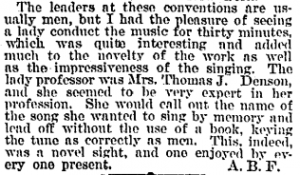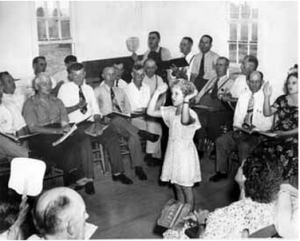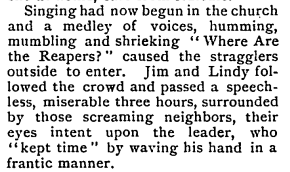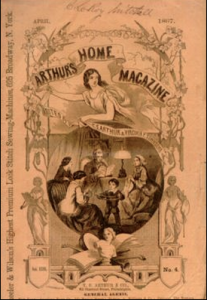A prominent event in Southern music making of the nineteenth and early twentieth centuries was the singing convention. In rural areas of the South, families from neighboring farms would gather to sing sacred Christian music from shape note singing books such as The Sacred Harp. The singers used this type of musical notation because its utilization of only four solfege syllables and corresponding symbols made reading music easier (than traditional Western notation), and most people were able to learn the notation by attending local singing schools. In the excerpt below, a journalist from the Atlanta Constitution reports his observations from the 1892 Chattahoochee Musical Convention near Carrollton, Georgia:

 Figure 1
Figure 1
The journalist seems to be writing for an urban audience that would not be familiar with such a singing tradition. By referencing how a mother might sing these songs “as a lullaby for her babe,” he emphasizes the music’s importance as a transmitter of culture for rural folk.
The shape note singing described above ensured that anyone could participate after little practice. The singing style at singing conventions reflected this inclusive attitude as well as valued the individual spirit. Singers were not expected to blend with one another; rather, they sang at full volume in order to praise God at their highest capacity. The ability of individuals to worship depended on their zeal as they sang, not their wealth, community standing, or musical sophistication. The clip below from the 2010 Chattahoochee Musical Convention shows that this atmosphere remains today.
Figure 2
As documents from the nineteenth century reveal, gender also carried less importance at singing conventions, which made them significant events in the lives of women. The Atlanta Constitution article states that women were allowed unusual freedoms like being permitted to lead songs at singing conventions.
Figure 3 and Figure 4
While female leadership seems to shock the journalist observing the convention, Mrs. Denson’s leadership makes sense in the context of the convention’s democratic ethos.
Singing conventions also held importance for women because they provided a venue at which members of the opposite sex could mingle. In the following short story excerpt, published in Arthur’s Home Magazine (a magazine marketed toward women), the author describes a young couple who attends a singing convention together not because they enjoy the singing but because the young woman’s parents allowed her to leave the house with young man only because they would be attending a singing convention.
Figure 5 and Figure 6
The women who read Arthur’s Home Magazine would have been interested in a story about a singing convention because the singing convention represented an arena in which a woman could participate in social activities without much attention paid to her gender.
Singing conventions were important in the lives of women for three main reasons: 1) they were integral to the transmission of culture, which has traditionally been the role of women, 2) they gave women leadership opportunities in worship, and 3) they provided social venues in which women had more freedom. However, while the democratic nature of the singing convention allowed for more equal treatment in regard to gender, it should not be overstated, considering that the spirit of inclusiveness did not extend to African-Americans. The tradition I have described above refers to white Southerners. Whether or not a similar treatment of gender occurred in separate African-American singing conventions remains a question for another blog.
Footnotes
A.B.F., “Old Time Singing: Devotees of the Old ‘Sacred Harp’ System of Melody,” The Atlanta Constitution (Atlanta, GA), Aug. 9, 1892, accessed Feb. 22, 2015, http://search.proquest.com/americanperiodicals/docview/194108303/fulltextPDF/1485C5C5DBB94281PQ/8?accountid=351
“Sacred Harp Chattahoochee Convention 2010,” Youtube video, posted by THEbubbleskid, September 9, 2010, https://www.youtube.com/watch?v=FQkYnRdkbqM
A.B.F., “Old Time Singing: Devotees of the Old ‘Sacred Harp’ System of Melody,” The Atlanta Constitution (Atlanta, GA), Aug. 9, 1892, accessed Feb. 22, 2015 http://search.proquest.com/americanperiodicals/docview/194108303/fulltextPDF/1485C5C5DBB94281PQ/8?accountid=351
Sacred Harp Singers. Available from http://marfapublicradio.org/blog/talk-at-ten/ryan-p-young-on-sacred-harp-singing/ (accessed Feb. 22, 2015)
Hester Grey. “At the Singing Convention,” Arthur’s Home Magazine (1880-1897) 65, no. 6 (1895): 570, accessed Feb. 22 2015, http://search.proquest.com/americanperiodicals/docview/124515702/fulltextPDF/$N/1?accountid=351
Arthur’s Home Magazine, 1867. Available from http://en.wikipedia.org/wiki/Arthur%27s_Lady%27s_Home_Magazine#mediaviewer/File:1867_Arthurs_Home_Magazine_v29_no4.png





I can’t tell you how glad I am that you focused on the issue of gender in shape note singing, H. This is an important and much-needed perspective that we just didn’t have time to get to in class. I suspect gender will remain a less explicit concern throughout the course, and I hope you’ll take the lead in bringing it up whenever you think it’s relevant. Keep up the good work!